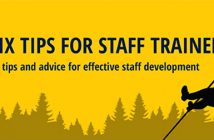Each year, Fortune magazine lists its “100 Best Companies to Work For” in the United States. This list was one of the first of its kind, and remains the industry standard for comparative evaluations of what makes companies attractive to employees. The selections are based on several criteria, not the least of which is a company’s “people practices”—or, more accurately, how leaders treat their employees.
During an interview with Bruce “Coach” Brown, director of operations and training at Royal Gorge Zip Line Tours and Castle Rock Zip Line Tours in Colorado, it dawned on me that many of the strategies he uses are very similar to those used by Fortune 100 Best companies—only adapted for the adventure park industry. Coach has many years of experience hiring and training staff. His parks have low turnover, very high staff return rates, and a very high percentage of staff who stay the entire season.
The following six strategies, which Coach is using at his park, are also being used at some of the most successful companies in the United States.
[1] Behavioral Interviewing
When conducting interviews, Coach engages in a conversation rather than a Q&A. He gives interviewees a chance to get comfortable and “burn off the nerves.” He probes candidates’ purpose rather than their qualifications. He looks for examples that show they have taken responsibility for something that has gone well, or has gone wrong. This is a test of character that, he says, indicates how the interviewee may behave when the boss isn’t around.
He also listens very carefully for clues that may reveal the interviewee’s passion and excitement for the job, which he sees as an indicator of how he or she will interact with customers.
“100 Best” Practice: A leading retailer of plush toys uses a “First Impressions Test” when screening applicants. The interviewer gets feedback from anyone who has encountered the interviewee throughout the interview process—this could include the person at the front desk of the office, or a greeter at one of the stores. This helps to get a sense of the “real” candidate, which isn’t always the same personality that shows up during the interview. They notice if the person smiles, says “thank you,” “hello,” etc. Feedback from frontline associates who had interaction with the candidate helps this retailer see if he or she is a good fit.
[2] Proper Pre-Screening
Coach invests time to learn about his interviewees. He tries to find their online presence (e.g., Facebook or Instagram profile) to get a sense of how they spend their time. If he sees something he does not like (excessive partying, inflammatory language, etc.), he knows to steer clear.
“100 Best” Practice: A global consulting company puts a twist on Coach’s strategy. Instead of looking at social media to double-check behavior, it’s leveraged as a scouting tool. The company identifies high-performing students in college (through Facebook affinity groups, etc.) and offers opportunities such as informational interviews or notifications of conferences the students may like. This positions the company as an innovative employer while keeping the talent pipeline full.
[3] Benefit of the Doubt
Coach talked a lot about an interviewee’s personal history as a predictor of future performance. Coach believes in people, and is comfortable giving people the opportunity to succeed, even if they’ve made a mistake or two in their lives. Giving the benefit of the doubt—assuming the best in someone—is a key driver of workplace trust. He also noted that he never lowers the bar for anyone, and all employees are held to a high standard of performance, regardless of their backstory.
“100 Best” Practice: A global insurance and financial services company has a robust intern program that focuses on bringing in associates from a variety of regions, backgrounds, socio-economic classes, races, etc. The company partners with organizations that provide opportunities to talented, entry-level candidates who want to work in its sector, but may not have the experience or network to easily do so.
[4] Tuning Into Staff’s Needs
Being aware of what employees want is an important aspect of maintaining high morale and employee retention. For example, some of Coach’s staff asked if they could set up an archery range in a remote, employee-only area so they could do something fun during downtime or after their shift. He OK’d it, and the staff love it.
This outlet is a “win” for the staff, but it’s also a venue for co-workers to get to know each other better, which fosters trust and builds a consistent culture.
“100 Best” Practice: An outdoor apparel and gear retailer offers its employees the opportunity to field-test private-brand products. Not only does this provide valuable feedback to the R&D department, it also gives employees first-hand experience with the items they will be selling. Employees can request a specific product to test based on their interests and location. After the test period, they write a product report with recommendations based on their experience, and post it to a private intranet.
[5] Smart Rewards and Recognition
Recognizing employees is vital to keeping them engaged for a full season. Coach believes that, at minimum, employees must know how to do their jobs and know how to treat guests. But it takes more than that to make a guest’s experience special. At his parks, if an employee’s name is mentioned in a five-star TripAdvisor rating, he or she earns a free lunch at a local restaurant. This encourages employees to maintain a professional standard of behavior even when the boss isn’t watching them.
“100 Best” Practice: A leading video game creator and publisher recognizes heroics, not heroes. Inspired by the Stanley Cup, this company created a “Champion’s Cup” award that acknowledges outstanding teamwork. The cup is engraved with the names of the team members who were recognized, and then passed around to various offices. The intention is to create one award (rather than lots of individual ones) to symbolize a growing collection of stories about those who exemplify the culture.
[6] Career Pathing
Finally, Coach encourages his employees to think beyond the “seasonal” aspect of the job by showing them pathways to future employment in the industry. In particular, he encourages all of his park staff to obtain ACCT certification, as well as to work at other parks for a few months. This gives staff a foundation of transferable experience, which they can use to build a career of their own. Coach believes in building the capacity of his staff, even though he knows some will take their skills elsewhere.
“100 Best” Practice: A mechanical construction company has a program to train new employees in a specialty trade that will help them acquire the skills for a great career. Many of these apprentices are family members or friends of existing employees.
The program has five phases. Phases 1, 3 and 5: classroom instruction with performance labs. Phases 2 and 4: on-the-job training under the guidance of a mentor. After graduation, they’re fully qualified at the entry level in their primary trade. Some continue training for a second trade once they are qualified in their primary trade. Having multi-trade knowledge and experience puts them on a path of growth and success.
Take a lesson from Coach—and some “100 Best” companies—and you just might find yourself in Fortune magazine one day.






